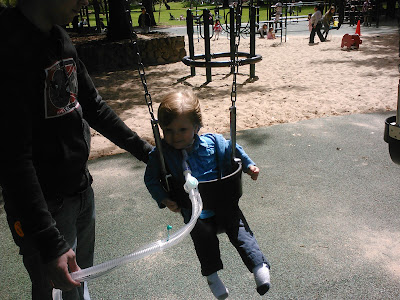Last July, an ENT surgeon gave Nate a tracheostomy, meaning there in an incision in his neck that goes through to his trachea. I don't care to think about how this was done, but there it is, a hole in his neck about the size of a pencil eraser. Into this hole goes a trach tube. This creates a new passage for him to breathe through. There is space around the trach tube within his trachea so he can breathe through his mouth and nose as well.
The trach tube is held in place by a velcro strap around his neck. The white thing around the tube is a piece of gauze that serves to prevent skin irritation and absorb yucky stuff.
Some people are able to use trachs without ventilators. Nate can breathe without the vent for 5-10 minutes at a time but is generally vented 24/7. The vent's job is to force air into his lungs to inflate them. Nate is allowed to initiate his own breaths and the vent will make sure he takes in enough air with each breath. If Nate is not initiating his own breaths, the vent will do it for him. We can also use the vent to give him oxygen, which thankfully we haven't had to do in a very long time.
| snazzy machine |
| The grey machine and water chamber is the humidifier. |
One important part of having a trach is keeping the air you breathe humidified, since it is not done naturally through the nose and mouth. When we're at home, Nate uses a humidifier that attaches to his vent. When we're out and about, he uses an HME, or heat-moisture exchanger, which attaches to his vent circuit and does the same job.
 |
| The little blue part attached to his vent circuit is the HME. |
So now you're in the know. Feel free to ask questions if I missed something.







